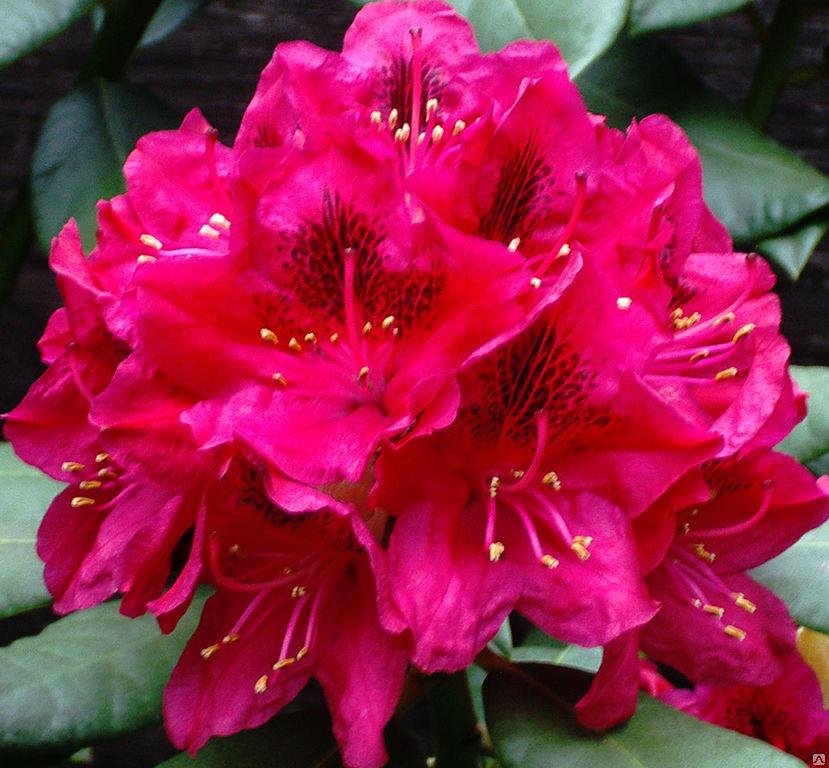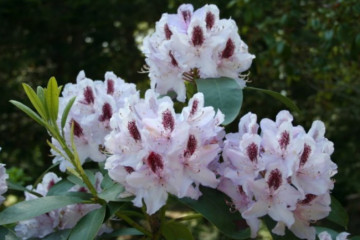Rhododendron Nova Zembla (Nova Zembla)
Content:
The Nova Zembla rhododendron is one of the most popular flowering shrubs among landscape designers. Any garden in which a flower garden with this plant is created begins to play with bright colors. Another plus of this particular variety of rhododendrons is winter hardiness, which makes it a good choice for cold regions.
History of the garden plant rhododendron
The name "rhododendron" comes from the Greek language and means "rosewood". The study and breeding of hybrid varieties of rhododendrons began in the 17th century. in England, but widespread in Europe, these shrubs received two centuries later. Among the scientists who had a hand in the research of the rosewood, there are D. Hooker, J. Forest.
E. Regel brought rhododendrons to pre-revolutionary Russia. But their popularity has come only recently. This is due to the fact that Russian flower growers have only recently begun to seriously study and create conditions for the successful breeding of this species.
Description of the plant
This plant, belonging to the Heather family, has over 600 different species. Among them you can find evergreen, semi- and deciduous shrubs, dwarf trees. Each species has a beautiful flowering.
Rhododendron Nova Zembla is an evergreen shrub. Description of the variety:
- the height of an adult plant is from 1.5 to 2.5 m;
- elliptical leaves of dark green color with a smooth shiny surface;
- has a superficial root system, a powerful trunk with spreading branches;
- in each spherical inflorescence up to 15-17 flowers of bright red or purple bloom, in the inner part the petals are darker. Flowers do not exude aroma;
- the period of blooming of inflorescences is the beginning of May and June.
Dutch breeder A. Costner was also involved in the cultivation of rhododendrons. The hybrid cultivar Nova Zembla was obtained by crossing the cultivar Parsons Grandiflorum and one of the Katevbin shrubs.
What is the difference from other types
The peculiarity of this variety is that it grows rapidly. In winter, those shoots that are crushed by snow survive, and the outer ones die from frost. Because of this, bushes in mid-latitudes do not grow in height, but grow in breadth.
Use in landscape design
This heather tree has a rather sprawling domed crown. Therefore, rhododendron should be planted where there is a lot of free space.
This variety will look great against the wall of a building to fill the space with bright accents, in the frame of a pond or near a gazebo. In large gardens, bright scarlet shrubs are also planted along the paths, combining Nova Zembla with flowers that bloom in a different period.
You can combine rhododendrons with conifers, which will harmonize not only externally with these bright bushes, but also give them the necessary shade.
Soil Requirements for Nova Zembla Rhododendron
The soil for this variety of rhododendrons should be light, well-drained and sufficiently acidic. To make the mixture yourself, you need to take:
- 3 pieces of leafy land;
- 2 parts of peat;
- 1 piece of coniferous litter.
In each planting hole, you need to add 50-100 g of complex mineral fertilizer.
Landing in open ground
The site for planting a rhododendron should be calm and shaded. The area behind the northern wall of the house is perfect, where not as much light penetrates as required by other flowering crops.
Rhododendron Nova Zembla is best planted in the spring before the flowering period. In this case, you will have to sacrifice the first flowers on the seedling in order to give it the opportunity to start up life juices for growth, and not for flowering.
Disembarkation process:
- A hole is dug about 50 cm deep and at least 70 cm wide.
- A drainage layer is laid out at the bottom (coniferous bark, pebbles, broken brick, etc.).
- Depending on the size of the varietal plant, the distance between the planting pits should be 70-200 cm.
- Plants are planted in holes, covered with earth.
- The soil around the seedlings is mulched with a peat or coniferous layer of 5-10 cm.
Mulching the soil will help preserve moisture in it, prevent weeds from growing around the seedling, and reduce the depth of soil freezing in the cold season.
Evergreen shrub care
Caring for the rhododendron variety Nova Zembla consists in regularly moistening the soil around the plant, weeding, and fertilizing. 2-3 times a week should be watered rosewood, each bush should take about 10 liters of water. The matte color of the leaves, the appearance of dark spots on them signals insufficient soil moisture. An excellent solution would be to use automatic sprayers.
For wintering, it is better to cover young trees with spruce branches, and the ground under them with burlap. Warming will be needed within 3-4 years after planting the seedling, until it finally takes root in a new place in a cold climate.
Top dressing and pruning
Compost or complex mineral compositions are suitable as fertilizers; they should be applied 2-3 times during the spring months. To help the rhododendron recover from flowering, you need to make phosphorus-potassium fertilizers.
This type of rhododendron does not need crown formation, since the inflorescences form a neat dome. You can cut off those branches that do not look aesthetically pleasing in the landscape design of the garden or interfere with the passage. After winter it is necessary to cut off dead branches.
Diseases and pests
Most often, hybrid rhododendrons are spoiled by pests such as bedbugs and spider mites. The first are located on the inside of the sheets, biting through them. You can get rid of rhododendron bugs with the help of Aktar and Fitoverm. Spider mites are treated in the classical way, that is, by treatment with an actara.
Of the diseases, rust and leaf mosaic are most often affected by this species. An excellent remedy against them is confidor.
Rhododendrons are not as difficult to care for as it might seem at first glance. Half of the success lies in the correctly selected hybrid variety, the other half - in the right place for planting it. The Nova Zemba variety will be a great garden decoration even in cold climates.




















